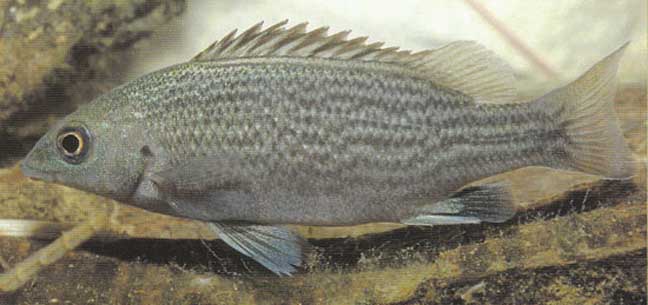- Classification
- ACTINOPTERYGII
- PERCIFORMES
- TERAPONTIDAE
- Syncomistes
- kimberleyensis
Kimberley Grunter, Syncomistes kimberleyensis Vari 1978

Kimberley Grunter, Syncomistes kimberleyensis. Source: Gerald R. Allen. License: All rights reserved
Kimberley Grunter, Syncomistes kimberleyensis Vari 1978
More Info
|
Distribution |
Known from the Bow River, Upper Ord River system, and the Durack and Pentecost rivers, Western Australia. Adults inhabits rock pools, stream and river margins with aquatic vegetation over sandy and rocky bottoms. |
|
Features |
Dorsal fin XII, 11-12; Anal fin III, 8; Pectoral fin 14-15; Pelvic fin I, 5; Lateral line scales 47-48; Vertebrae 11+14; Gill rakers 6+1+16. Body slender, depth 2.54-2.59 in SL, ovate, not very compressed; dorsal profile slightly more pronounced than ventral, slightly convex from snout to rear of skull, straight from rear of skull to dorsal origin; ventral profile convex to anus. Head length 3.24-3.36 in SL. Snout length 3.08-3.3 in HL. Nostrils close together, separation equal to diameter of posterior nostril; both nostrils with free cutaneous edges, posterior nostril tube-like. Eye width 3.5-3.9 in HL. Interorbital region smooth. Upper jaw fleshy, slightly longer than lower which is flattened and rounded; jaw length 3.5-3.7 in HL; gape nearly horizontal; maxillary reaching to vertical through posterior nostril; each jaw with outer series of enlarged, distally flattened brown-tipped teeth oriented slightly laterally and internal series of smaller similarly shaped teeth; symphysis of dentary with edentulous bump corresponding in position to a median groove between the premaxillaries that also lacks dentition; vomer and palatines without teeth. Lacrimal serrate. Preoperculum with 7-8 coarse serrations in the region of the angle and with horizontal edge smooth. Lower opercular spine longer and stronger; not extending beyond edge of opercular lobe. cleithrum exposed; serrate along posterior edge. Supracleithrum exposed. Posttemporal exposed; serrate along posterior edge. Scales finely ctenoid; transverse scales 6-7/1/14-15; lateral line continuous, smoothly curved; 12-13 pre-dorsal scales to occiput; cheek scales in 4 rows; 2 irregular rows of scales in sheath at base of dorsal fin, sheath extending to fourth or fifth dorsal ray; three rows of scales in sheath at base of anal fin, sheath extending to fourth anal ray.Dorsal fin continuous, base 1.95-2.0 in SL; spinous portion arched; fourth spine longest, 2.05-2.3 in HL, about same length as or slightly longer than longest dorsal ray; spines following longest decreasing gradually in length to penultimate, which is about same length as last; longest dorsal ray 2.05-2.3 in HL; soft dorsal rounded. Second anal spine longest, 2.15-2.35 in HL, twice length of first; slightly longer than third; longest anal ray 1.7-2.0 in HL; soft anal rounded. Pectoral fins asymmetrically pointed; fifth ray longest. Pelvic fins inserted posterior to vertical through dorsal origin. Pelvic fins pointed; first ray longest, reaching less than one-half distance to anus. Caudal finslightly emarginate. |
|
Size |
To at least 20 cm SL |
|
Colour |
Adults bluish green overall with darker scale margins and becoming white ventrally. Also with a silver stripe below eye to snout and a dark spot on upper edge of gill cover. Juveniles speckled with very small brown spots and eight horizontal, irregular wavy brown stripes. Dorsal portion of head and opercle below lower opercular spine darker. Membranes of spinous and lower third of soft portion of dorsal fin pale brown. Anal fin membranes with darker blotch on middle of rays. Pelvic fins pigmented. Pectoral fins clear. Caudal fin with basal marks continuous with fourth to sixth body stripes. |
|
Feeding |
Herbivore - feeds mostly on filamentous algae. |
|
Biology |
Little is known of the reproductive biology of this species. Females spawn demersal eggs that are guarded and fanned by the male parent. |
|
Fisheries |
Reportedly a peaceful aquarium fish. |
|
Conservation |
|
|
Remarks |
To date only juveniles and sub-adults of this species have been collected. |
|
Etymology |
Syncomistes is from Greek meaning 'gatherer' in reference to the algae-cropping habits of the members of this genus. The specific name kimberleyensis refers to the type locality, the Kimberley region of Western Australia. |
|
Species Citation |
Syncomistes kimberleyensis Vari, 1978, Bull. Amer. Mus. Nat. Hist. 159(5): 315. Type locality: Bow River, Western Australia. |
|
Author |
Gomon, M.F. & Bray, D.J. 2020 |
Kimberley Grunter, Syncomistes kimberleyensis Vari 1978
References
Allen, G.R. (1982). Inland Fishes of Western Australia. Perth : Western Australian Museum 86 pp. 6 figs 20 pls.
Allen, G.R., Midgley, S.H. & Allen, M. (2002). Field guide to the freshwater fishes of Australia. Perth : Western Australian Museum 394 pp.
Leggett, R. & Merrick, J.R. (1987). Australian Native Fishes for Aquariums. Artarmon : J.R. Merrick Publications 241 pp. 142 figs.
Merrick, J.R. & G.E. Schmida. 1984. Australian freshwater fishes: biology and management. Griffin Press Ltd., South Australia. 409 p.
Morgan, D.L., Allen, G.R., Pusey, B.J. & Burrows, D.W. 2011. A review of the freshwater fishes of the Kimberley region of Western Australia. Zootaxa 2816: 1-64
Shelley, J.J., Delaval, A. & Le Feuvre, M.C. 2017. A revision of the grunter genus Syncomistes (Teleostei, Terapontidae, Syncomistes) with descriptions of seven new species from the Kimberley region, northwestern Australia. Zootaxa 4367(1): 1-103 DOI: http://dx.doi.org/10.11646/zootaxa.4367.1.1 Abstract
Shelley, J.J., Gomon, M.F. & Le Feuvre, M.C. 2018. Family Terapontidae. pp. 118-158 in Shelley, J.J., Morgan, D.L., Hammer, M.P., Le Feuvre, M.C., Moore, G.I., Gomon, M.F., Allen, M.G. & Saunders, T. (eds) A field guide to the freshwater fishes of the Kimberley. Murdoch University, Murdoch, Western Australia, 262 pp.
Unmack, P.J. 2001. Biogeography of Australian freshwater fishes. Journal of Biogeography 28: 1053-1089.
Vari, R. P. (1978) The terapon perches (Percoidei, Teraponidae). A cladistic analysis and taxonomic revision. Bulletin of the American Museum of Natural History 159(5): 175-340.
Wager, R. 1996. Syncomistes kimberleyensis. In: IUCN 2012. IUCN Red List of Threatened Species. Version 2012.2.

